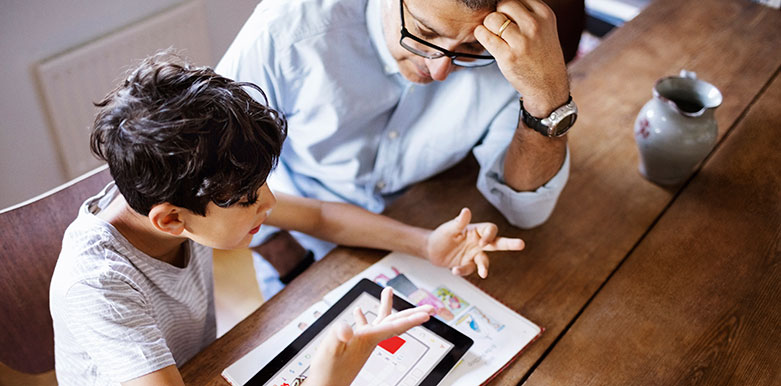Before 2020, the concept of ‘connected education’ was much discussed, but talk of holographic students or robot teachers seemed to owe more to science fiction than the reality of teaching children. However, 12 months ago, countries around the world had to suddenly pivot to remote learning, often starting completely from scratch. Andwhilegovernments, schools and educators tried their best, around the world, as many as 1.6 billion schoolchildren faced disrupted learning – and millions of teachers had to navigate an online educational environment for the very first time, sometimes with limited support.
As students (and their parents) start to look towards returning to full-time in-person education, it is clear that our school systems will remain much more digital than before: there are many aspects of remote learning that were adopted out of necessity that have improved how children learn and enhanced the digital skills they need for the future.
One of the greatest opportunities comes from the ability to open up new locations and opportunities for children from the comfort of their classrooms – either by bringing different groups of students together remotely, or by taking them on trips to more exotic or far-flung places than they could even visit for real. Last January, for example, we were able to take students from Kakuma Refugee Camp in Kenya on a tour of the National Gallery in London, over 6,000 miles away, using 5G and virtual reality (VR) headsets. In the school of the near-future, such trips can become commonplace.
VR and augmented reality (AR) are also increasingly affordable and accessible to schools, especially as the 5G rollout across Europe accelerates and provides the fast, stable, secure connectivity to support it. These new technologies are able to make future lessons even more interactive and engaging – as the experience of students in Milan has shown.
And although we have a greater appreciation than ever before of the important of in-person schooling for children – both when it comes to supporting their learning in the classroom and in making friends and staying healthy – the ability to deliver effective remote and hybrid learning means that we can support those who may be unable to attend school for extended periods of time. The AV1 robot is one way of ensuring children with long-term illnesses are able to remain a part of their classrooms, and as technology and connectivity in schools and homes continue to improve, these solutions can become the norm, rather than an exotic exception.
However, although digital education will continue to offer significant opportunities even after the pandemic has passed, there are still considerable barriers to making this a reality for all children. Although 2 billion people already use mobile internet to access educational information for themselves or their children as many as two-thirds of school-age children still have no internet access at home, and remote learning remains out of reach for at least 500 million students. A shift to online learning and digital technologies without strong, accessible connectivity and adequate digital skills leaves many at risk of being left behind.
It’s not just children’s digital skills we need to consider – it’s vitally important that we ensure teachers are able to keep pace with technological developments too. But even those teachers with advanced digital skills are not IT specialists. Expecting them to be able to identify, set up and maintain complex, secure educational systems is unreasonable.
That’s why systems like Connected Education can help reduce the burden on teachers and school administrators, and accelerate the availability of digital education. Connected Education is an end-to-end package for educational establishments that guarantees secure access to technology for students, teachers and schools. It also enables teachers to host lessons in or outside of the classroom and use interactive tools.
It includes connectivity, tablets and laptops for the classroom, inbuilt filtering for secure browsing and collaboration software that helps students work with their peers virtually and gain access to an infinite amount of learning resources. It has already reached over 2,000 European educational institutions and 260,000 users and we aim to continue rolling out this solution, in partnership with national governments and schools across Europe.
If we are to build back better from this crisis, we need to do it in a digital, sustainable and inclusive way so we do not let our human capital go to waste. We must step up collaboration and partnership between governments, educational institutions and the private sector to fix the wider problems facing students and teachers, including access to reliable networks, affordable devices and basic digital skills.
One way of making sure we deliver on this promise of inclusive education, and build the digital skills of the future under Next Generation EU, is to ensure that Europe’s recovery funds allocation and spend is measured and monitored against the actual progress and impact of digitalisation. This should be linked to improvements in the Digital Economy and Societal Index (DESI) across Member States.
According to last year’s DESI, Member States are making good progress in improving their Human Capital scores – i.e. the percentage of their citizens with basic digital skills. Nevertheless, there are still too many people being left behind. Only two countries, Finland and Sweden, score more than 70 out of 100 for the human capital DESI score – and Italy, the lowest performance country, scores just 32. The gender gap also remains stark: on average, just 1.4% of ICT specialists across Europe are female.
However, if all Member States reached a score of 90 on the DESI: EU GDP could increase by 2.5% each year and be 7.2% higher at the end of the 2021-2027 Multiannual Financial Framework period – but, crucially, 90 for 27 wouldhelp us all create resilient digital economies and societies, making sure no country or citizen is left behind in the digital journey. It would place a less fragmented and stronger Europe in a leading position globally, supporting the digital development of its citizens and next generations to come.

























